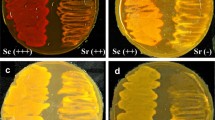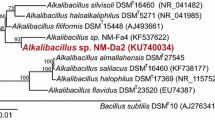Abstract
The extracellular soluble proteins of 15 different isolates comprising 9 different physiological races ofCladosporium fulvum were harvested from 3 to 4 weeks old shake cultures. The culture filtrates were purified by gel filtration over Sephadex G-25 and the Vo-fractions were freeze-dried. These preparations were submitted to disc gel electrophoresis on polyacrylamide gels at pH 9.5 at circa 4°C.
The electrophoretical protein patterns appeared to differ for each isolate irrespective of the physiological race to which they belong. The various isolates originated from different sites in the Netherlands.
Samenvatting
De extracellulaire oplosbare eiwitten van 15 verschillende isolaten, behorend tot 9 verschillende fysiologische rassen vanCladosporium fulvum, werden verkregen met behulp van Sephadex G-25 gelfiltratie van 3 tot 4-weken-oude filtraten van schudcultures. De drooggevroren fracties werden onderworpen aan elektroforese op polyacryl amide gels bij pH 9.5 en ongeveer 4°C.
De met elektroforese verkregen eiwitpatronen bleken verschillend voor ieder isolaat onafhankelijk van het fysio waartoe zij behoren. Deze isolaten waren van verschillende plaatsen in Nederland afkomstig.
Similar content being viewed by others
References
Bennick, A., 1968. Detection of persulfate in acrylamide gels. Analyt. Biochem. 26:453–457.
Chrambach, A., Reisfeld, R. A., Wijckoff, M. & Zaccari, J., 1967. A procedure for rapid and sensitive staining of protein fractionated by polyacrylamide gel electrophoresis. Analyt. Biochem. 20:150–154.
Clare, B. G., 1963. Starch-gel electrophoresis of proteins as an aid in identifying fungi. Nature, Lond. 200:803–804.
Davis, B. J., 1964. Disc electrophoresis II. Method and application to human serum proteins. Ann. N. Y. Acad. Sci. 121:404–427.
Durbin, R. D., 1966. Comparative gel electrophoretic investigation of the protein patterns ofSeptoria species. Nature, Lond. 210:1186–1187.
Dijkman, A. van, 1972. Natural resistance of tomato plants toCladosporium fulvum. A biochemical study. Ph. D. Thesis, State University of Utrecht, the Netherlands.
Dijkman, A. van & Kaars Sijpesteijn, A., 1971. A biochemical mechanism for the gene-for-gene resistance of tomato toCladosporium fulvum. Neth. J. Pl. Path. 77:14–24.
Dijkman, A. van & Kaars Sijpesteijn, A., 1973. Leakage of pre-absorbed32P from tomato leaf discs infiltrated with high molecular weight products of incompatible races ofCladosporium fulvum. Physiol. Pl. Path. 3: 57–67.
Gill, H. S. & Powell, D., 1963. Differentiation of three species ofPhytophthora by polyacrylamide gel electrophoresis. Phytopathology 57:812.
Gill, H.S. & Powell, D., 1968. Polyacrylamide gel (disc) electrophoresis of physiologic races A 1 to A 8 ofPhytophthora fragariae. Phytopathology 58:772–723.
Hall, R., Zentmyer, G. A. & Erwin, D. C., 1970. Approach to taxonomy ofPhytophthora through acrylamide gel electrophoresis of proteins. Phytopathology 59:770–774.
Hubbeling, N., 1968. Attack of hitherto resistant tomato varieties by a new race ofCladosporium fulvum and resistance against it. Meded. Rijksfac. Landbouwwetensch. Gent 33:1011–1017.
Kooistra, E., 1964. Recent experiences of breeding leaf mould resistant tomatoes. Euphytica 13: 103–109.
Loening, O. E., 1967. The fractionation of high molecular weight RNA by polyacrylamide gel electrophoresis. Biochem. J. 102:251–257.
Lowry, O. H., Rosebrough, N. J., Farr, A. L. & Randall, R. J., 1951. Protein measurement with the Folin phenol reagent. J. biol. Chem. 193:265–275.
Macko, V. A., Novacky, A. & Stahmann, M. A., 1967. Protein patterns from uredospores ofPuccinia graminis var.tritici. Phytopath. Z. 58:122–127.
Maurer, H. R., 1968. Disk-Electrophorese. W. de Gruyter & Co., Berlin (West-Germany), pp. 64–67.
Ornstein, L., 1964. The disc electrophoresis I. Background and theory. Ann. N.Y. Acad. Sci. 121: 321–349.
Shipton, W. A. & Fleischmann, G., 1969. Disc electrophoresis of proteins from uredospores of races ofPuccinia coronata f.sp.avenae. Phytopathology 59:883.
Stipes, R.J., 1967. Disc electrophoresis of mycelial proteins fromCeratocystis species. Phytopathology 57:833.
Trudgill, D. L. & Carpenter, J. M., 1971. Disk electrophoresis of proteins ofHeterodera species and pathotypes ofHeterodera rostochiensis. Ann. appl. Biol. 69:35–41.
Author information
Authors and Affiliations
Rights and permissions
About this article
Cite this article
Van Dijkman, A., Dieleman, S.J. & Sijpesteijn, A.K. Differences in disc gel electrophorese pattern of soluble proteins excreted by different physiological races and isolates of Cladosporium fulvum. Netherlands Journal of Plant Pathology 79, 70–80 (1973). https://doi.org/10.1007/BF02083669
Accepted:
Issue Date:
DOI: https://doi.org/10.1007/BF02083669




